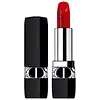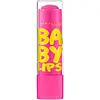What's inside
What's inside
 Key Ingredients
Key Ingredients

 Benefits
Benefits

 Concerns
Concerns

 Ingredients Side-by-side
Ingredients Side-by-side

Polyglyceryl-2 Triisostearate
EmulsifyingHydrogenated Polyisobutene
EmollientOctyldodecanol
EmollientSynthetic Wax
AbrasiveC10-30 Cholesterol/Lanosterol Esters
EmulsifyingTrimethylolpropane Triisostearate
EmollientHydrogenated Microcrystalline Wax
Emulsion StabilisingPolybutene
Cera Alba
EmollientCI 77220
Cosmetic ColorantEthylhexyl Palmitate
EmollientPolyethylene
AbrasiveButyrospermum Parkii Butter
Skin ConditioningCalcium Aluminum Borosilicate
Disteardimonium Hectorite
StabilisingPrunus Amygdalus Dulcis Oil
Skin ConditioningButyrospermum Parkii Butter Unsaponifiables
Skin ConditioningParfum
MaskingPaeonia Officinalis Flower Extract
TonicSimmondsia Chinensis Seed Oil
EmollientPropylene Carbonate
SolventPunica Granatum Flower Extract
Skin ConditioningPolyglyceryl-3 Diisostearate
EmulsifyingTrihydroxystearin
Skin ConditioningPropyl Gallate
AntioxidantTocopherol
AntioxidantSodium Hyaluronate
HumectantGlucomannan
Skin ConditioningCI 12085
Cosmetic ColorantCI 15850
Cosmetic ColorantCI 15985
Cosmetic ColorantCI 17200
Cosmetic ColorantCI 19140
Cosmetic ColorantCI 42090
Cosmetic ColorantCI 45380
Cosmetic ColorantCI 45410
Cosmetic ColorantCI 73360
Cosmetic ColorantCI 77163
Cosmetic ColorantCI 77491
Cosmetic ColorantCI 77492
Cosmetic ColorantCI 77499
Cosmetic ColorantCI 77742
Cosmetic ColorantCI 77891
Cosmetic ColorantPolyglyceryl-2 Triisostearate, Hydrogenated Polyisobutene, Octyldodecanol, Synthetic Wax, C10-30 Cholesterol/Lanosterol Esters, Trimethylolpropane Triisostearate, Hydrogenated Microcrystalline Wax, Polybutene, Cera Alba, CI 77220, Ethylhexyl Palmitate, Polyethylene, Butyrospermum Parkii Butter, Calcium Aluminum Borosilicate, Disteardimonium Hectorite, Prunus Amygdalus Dulcis Oil, Butyrospermum Parkii Butter Unsaponifiables, Parfum, Paeonia Officinalis Flower Extract, Simmondsia Chinensis Seed Oil, Propylene Carbonate, Punica Granatum Flower Extract, Polyglyceryl-3 Diisostearate, Trihydroxystearin, Propyl Gallate, Tocopherol, Sodium Hyaluronate, Glucomannan, CI 12085, CI 15850, CI 15985, CI 17200, CI 19140, CI 42090, CI 45380, CI 45410, CI 73360, CI 77163, CI 77491, CI 77492, CI 77499, CI 77742, CI 77891
Polybutene
Octyldodecanol
EmollientIsopropyl Myristate
EmollientPetrolatum
EmollientEthylhexyl Methoxycinnamate
UV AbsorberPolyethylene
AbrasiveOzokerite
Emulsion StabilisingEthylhexyl Salicylate
UV AbsorberButyrospermum Parkii Butter
Skin ConditioningDiisostearyl Malate
EmollientCandelilla Cera
EmollientVp/Hexadecene Copolymer
Silica Dimethyl Silylate
EmollientParfum
MaskingCalcium Aluminum Borosilicate
Pentaerythrityl Tetra-Di-T-Butyl Hydroxyhydrocinnamate
AntioxidantTocopherol
AntioxidantTocopheryl Acetate
AntioxidantAlumina
AbrasiveAroma
Silica
AbrasiveIsopropyl Palmitate
EmollientPentaerythrityl Tetraisostearate
EmollientLimonene
PerfumingSynthetic Fluorphlogopite
Calcium Sodium Borosilicate
Benzyl Benzoate
AntimicrobialCentella Asiatica Extract
CleansingAluminum Hydroxide
EmollientCitral
PerfumingLinalool
PerfumingHexyl Cinnamal
PerfumingTin Oxide
AbrasiveGeraniol
PerfumingEugenol
PerfumingAloe Barbadensis Extract
Skin ConditioningMel
EmollientCalcium Pantothenate
Ascorbic Acid
AntioxidantDimethicone
EmollientSodium Chondroitin Sulfate
Skin ConditioningAtelocollagen
Skin ConditioningCI 77891
Cosmetic ColorantMica
Cosmetic ColorantCI 45410
Cosmetic ColorantCI 77491
Cosmetic ColorantCI 77492
Cosmetic ColorantCI 77499
Cosmetic ColorantCI 15850
Cosmetic ColorantCI 45380
Cosmetic ColorantCI 19140
Cosmetic ColorantCI 42090
Cosmetic ColorantCI 15985
Cosmetic ColorantCI 75470
Cosmetic ColorantPolybutene, Octyldodecanol, Isopropyl Myristate, Petrolatum, Ethylhexyl Methoxycinnamate, Polyethylene, Ozokerite, Ethylhexyl Salicylate, Butyrospermum Parkii Butter, Diisostearyl Malate, Candelilla Cera, Vp/Hexadecene Copolymer, Silica Dimethyl Silylate, Parfum, Calcium Aluminum Borosilicate, Pentaerythrityl Tetra-Di-T-Butyl Hydroxyhydrocinnamate, Tocopherol, Tocopheryl Acetate, Alumina, Aroma, Silica, Isopropyl Palmitate, Pentaerythrityl Tetraisostearate, Limonene, Synthetic Fluorphlogopite, Calcium Sodium Borosilicate, Benzyl Benzoate, Centella Asiatica Extract, Aluminum Hydroxide, Citral, Linalool, Hexyl Cinnamal, Tin Oxide, Geraniol, Eugenol, Aloe Barbadensis Extract, Mel, Calcium Pantothenate, Ascorbic Acid, Dimethicone, Sodium Chondroitin Sulfate, Atelocollagen, CI 77891, Mica, CI 45410, CI 77491, CI 77492, CI 77499, CI 15850, CI 45380, CI 19140, CI 42090, CI 15985, CI 75470
 Reviews
Reviews

Ingredients Explained
These ingredients are found in both products.
Ingredients higher up in an ingredient list are typically present in a larger amount.
This ingredient is also known as shea butter. It is an effective skin hydrator and emollient.
Emollients help soothe and soften your skin. It does this by creating a protective film on your skin. This barrier helps trap moisture and keeps your skin hydrated. Emollients may be effective at treating dry or itchy skin.
Shea butter is rich in antioxidants. Antioxidants help fight free-radicals, or molecules that may harm the body. It is also full of fatty acids including stearic acid and linoleic acid. These acids help replenish the skin and keep skin moisturized.
While Shea Butter has an SPF rating of about 3-4, it is not a sunscreen replacement.
Shea butter may not be fungal acne safe. We recommend speaking with a professional if you have any concerns.
Learn more about Butyrospermum Parkii ButterCalcium Aluminum Borosilicate is made up of calcium, aluminum, and silicates. It is a glass-like material. In cosmetics, it comes in the form of flakes or microspheres.
Calcium aluminum borosilicate is a bulking agent, meaning it helps thicken a product.
This ingredient is created by slowly mixing several minerals, including kaolin clay.
Although “aluminum” in an ingredient name can raise red flags for some consumers, the form and usage context matter significantly. For typical topical applications, there is no substantial evidence of health risks - such as cancer, neurotoxicity, or systemic “aluminum overload.”
Learn more about Calcium Aluminum BorosilicateCi 15850 is the pigment color red. It is an azo dye and created synthetically.
Azo dyes need to be thoroughly purified before use. This allows them to be more stable and longer-lasting.
This ingredient is common in foundations, lipsticks, and blushes. This color is described as brown/orangey red.
It has many secondary names such as Red 6 and Red 7. According to a manufacturer, Red 6 usually contains aluminum.
Learn more about CI 15850Ci 15985 is a dye made from petroleum. It is synthetically created and approved by the FDA for use in foods and cosmetics.
The color of this dye is orange/yellow.
This ingredient can be found in makeup, sun care, and skincare.
Learn more about CI 15985CI 19140 is also known as Tartrazine. Tartrazine is a synthetic dye used in cosmetics, foods, and medicine to add a yellow color.
Tartrazine is created from petroleum and is water-soluble.
Some people may experience allergies from this dye, especially asthmatics and those with an aspirin intolerance.
Learn more about CI 19140Ci 42090 is a synthetic dye created from petroleum. It is used to give a bright blue color to cosmetics, medicine, and food.
Ci 45380 is a synthetic dye that comes from coal or tar sources. Due to this, it is often used in small quantities.
A common name for this dye is Red 22. Red 22 imparts a warm reddish color.
Similar to Red 27, this dye changes color based on pH and moisture levels.
This dye is colorless when dry but turns pink between pH levels 0.0 to ~3.0.
Learn more about CI 45380CI 45410 is a synthetic red-pigment and dye.
It often goes by both Red 28 or Red 27; manufacturers label both ingredients as CI 45410.
This dye is commonly found in makeup because it imparts a vivid color. Some types of this dye change color based on pH level and interaction with moisture:
Your skin has a natural pH of around 4.5 - 5.5.
According to the FDA, CI 45410 is not permitted for use in eye products.
Red 27 is a flourescein dye and commonly used as a fluorescent tracer in medicine.
Learn more about CI 45410Ci 77491 is also hydrated iron III oxide. It's sole purpose is to give a red/pink hue to products.
Iron III oxides are classified as inorganic chemicals for coloring.
Synthetically created Ci 77491 is considered safer than those naturally found. This is because the synthetically created version may contain less impurities. Iron oxides are generally non-toxic and non-allergenic.
Learn more about CI 77491Ci 77492 is also hydrated iron III oxide. It's sole purpose is to give a yellow hue to products.
Iron III oxides are classified as inorganic chemicals for coloring.
Synthetically created Ci 77492 is considered safer than those naturally found. This is because the synthetically created version may contain less impurities. Iron oxides are generally non-toxic and non-allergenic.
Learn more about CI 77492Ci 77499 is also hydrated iron III oxide. It is created from mixing red and black iron oxides. This helps give shades of darkness to a product.
Iron III oxides are classified as inorganic chemicals for coloring.
Ci 77891 is a white pigment from Titanium dioxide. It is naturally found in minerals such as rutile and ilmenite.
It's main function is to add a white color to cosmetics. It can also be mixed with other colors to create different shades.
Ci 77891 is commonly found in sunscreens due to its ability to block UV rays.
Learn more about CI 77891Octyldodecanol is a fatty alcohol. It is primarily used to enhance the texture of products.
As an emulsifier, Octyldodecanol helps prevent the oils and waters from separating. It also prevents ingredients from creating foam when shaken.
Octyldodecanol is created by reducing fatty acid to an alcohol.
Due to its high molecular weight, it does not get absorbed into the skin.
Learn more about OctyldodecanolParfum is a catch-all term for an ingredient or more that is used to give a scent to products.
Also called "fragrance", this ingredient can be a blend of hundreds of chemicals or plant oils. This means every product with "fragrance" or "parfum" in the ingredients list is a different mixture.
For instance, Habanolide is a proprietary trade name for a specific aroma chemical. When used as a fragrance ingredient in cosmetics, most aroma chemicals fall under the broad labeling category of “FRAGRANCE” or “PARFUM” according to EU and US regulations.
The term 'parfum' or 'fragrance' is not regulated in many countries. In many cases, it is up to the brand to define this term.
For instance, many brands choose to label themselves as "fragrance-free" because they are not using synthetic fragrances. However, their products may still contain ingredients such as essential oils that are considered a fragrance by INCI standards.
One example is Calendula flower extract. Calendula is an essential oil that still imparts a scent or 'fragrance'.
Depending on the blend, the ingredients in the mixture can cause allergies and sensitivities on the skin. Some ingredients that are known EU allergens include linalool and citronellol.
Parfum can also be used to mask or cover an unpleasant scent.
The bottom line is: not all fragrances/parfum/ingredients are created equally. If you are worried about fragrances, we recommend taking a closer look at an ingredient. And of course, we always recommend speaking with a professional.
Learn more about ParfumPolybutene is used to help control the viscosity of a product. This just means it helps adjusts the texture.
It is a polymer and does not get absorbed into the skin due to its large size.
Studies found this ingredient did not irritate skin in concentrations below 15%.
Learn more about PolybutenePolyethylene is a synthetic ingredient that helps the skin retain moisture. It is a polymer.
It is also typically used within product formulations to help bind solid ingredients together and thicken oil-based ingredients. When added to balms and emulsions, it helps increase the melting point temperature.
Tocopherol (also known as Vitamin E) is a common antioxidant used to help protect the skin from free-radicals and strengthen the skin barrier. It's also fat soluble - this means our skin is great at absorbing it.
Vitamin E also helps keep your natural skin lipids healthy. Your lipid skin barrier naturally consists of lipids, ceramides, and fatty acids. Vitamin E offers extra protection for your skin’s lipid barrier, keeping your skin healthy and nourished.
Another benefit is a bit of UV protection. Vitamin E helps reduce the damage caused by UVB rays. (It should not replace your sunscreen). Combining it with Vitamin C can decrease sunburned cells and hyperpigmentation after UV exposure.
You might have noticed Vitamin E + C often paired together. This is because it is great at stabilizing Vitamin C. Using the two together helps increase the effectiveness of both ingredients.
There are often claims that Vitamin E can reduce/prevent scarring, but these claims haven't been confirmed by scientific research.
Learn more about Tocopherol